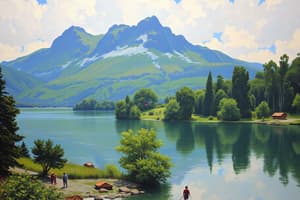Podcast
Questions and Answers
भूआकृतिकी के मौलिक सिद्धांतों में कौन-कौन से विषय शामिल हैं?
भूआकृतिकी के मौलिक सिद्धांतों में कौन-कौन से विषय शामिल हैं?
ज्वालामुखियाँ, नाइट्रोजन चक्र, रेगिस्तान
नाइट्रोजन चक्र क्या है?
नाइट्रोजन चक्र क्या है?
नाइट्रोजन चक्र एक जैव-भूगैरिकी चक्र है जो नाइट्रोजन के भूमि, वायु और जल के माध्यम से गति का वर्णन करता है।
रेगिस्तान कैसे परिभाषित किया जा सकता है?
रेगिस्तान कैसे परिभाषित किया जा सकता है?
रेगिस्तान उसके कम वर्षा, अत्यधिक तापमान और वनस्पति की कमी के साथ भूमि के क्षेत्रों को वर्णित करने वाले होते हैं।
किस प्रकार सेडीमेंटरी रॉक्स बनते हैं?
किस प्रकार सेडीमेंटरी रॉक्स बनते हैं?
क्या है ग्रीनहाउस प्रभाव?
क्या है ग्रीनहाउस प्रभाव?
वायुमंडलीय दबाव क्या है?
वायुमंडलीय दबाव क्या है?
क्या है कार्बन परिपथ?
क्या है कार्बन परिपथ?
समय क्षेत्र क्या है?
समय क्षेत्र क्या है?
थर्मोडायनामिक्स के कानून क्या हैं?
थर्मोडायनामिक्स के कानून क्या हैं?
Flashcards are hidden until you start studying
Study Notes
Fundamentals of Physical Geography
Physical geography is a subfield of geography that focuses on the natural environment, including Earth's seasons, climate, atmosphere, soil, streams, landforms, and oceans. It seeks to understand the natural world and how it has shaped human civilization. The field is divided into various topics, including volcanoes, the nitrogen cycle, deserts, sedimentary rocks, time zones, the greenhouse effect, atmospheric pressure, laws of thermodynamics, and more. In this article, we will explore the fundamentals of physical geography, focusing on these topics.
Volcanoes
Volcanoes are openings in the Earth's surface where molten rock, ash, and gas escape. They play a crucial role in shaping the Earth's surface and can have significant impacts on the environment and human life. Understanding the mechanisms behind volcanic eruptions and their effects is essential in physical geography.
The Nitrogen Cycle
The nitrogen cycle is a biogeochemical cycle that describes the movement of nitrogen through the Earth's atmosphere, soil, and water. Nitrogen is essential for life, and understanding the processes that regulate its availability is crucial for maintaining ecosystems and supporting human agriculture.
Deserts
Deserts are areas of the Earth's surface characterized by low precipitation, extreme temperatures, and a lack of vegetation. Understanding the factors that contribute to desert formation and the ecological processes that occur in these environments is essential for physical geographers.
Sedimentary Rocks
Sedimentary rocks are formed from the accumulation and consolidation of sediments, such as sand, silt, and clay. They provide information about the Earth's history and the processes that have shaped its surface. Studying sedimentary rocks is essential for understanding the geological past and predicting future changes.
Time Zones
Time zones are regions of the Earth that have the same standard time. Understanding the factors that determine time zones and how they are used to organize human life is essential for physical geographers.
The Greenhouse Effect
The greenhouse effect is the process by which certain gases in the Earth's atmosphere trap heat from the sun and maintain a stable climate. Understanding the greenhouse effect and its impact on the Earth's climate is crucial for predicting future changes and mitigating the effects of climate change.
Atmospheric Pressure
Atmospheric pressure is the force exerted by the weight of the Earth's atmosphere on the Earth's surface. Understanding atmospheric pressure and how it affects weather patterns and other geological processes is essential for physical geographers.
Laws of Thermodynamics
Laws of thermodynamics are fundamental principles that describe the behavior of energy and matter in the universe. Understanding these laws and their implications for the Earth's climate and ecosystems is essential for physical geographers.
Carbon Cycle
The carbon cycle is a biogeochemical cycle that describes the movement of carbon through the Earth's atmosphere, land, and water. Understanding the carbon cycle and its implications for the Earth's climate and ecosystems is crucial for physical geographers.
Deposition
Deposition is the process by which particles are removed from a fluid and settle onto a surface. Understanding the mechanisms behind deposition and its role in shaping the Earth's surface is essential for physical geographers.
In conclusion, physical geography is a diverse and essential field of study that seeks to understand the natural world and its impact on human civilization. By studying topics such as volcanoes, the nitrogen cycle, deserts, sedimentary rocks, time zones, the greenhouse effect, atmospheric pressure, laws of thermodynamics, the carbon cycle, and deposition, physical geographers can gain a deeper understanding of the Earth's systems and processes.
Studying That Suits You
Use AI to generate personalized quizzes and flashcards to suit your learning preferences.




